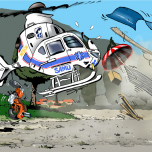Safety instructions to ground personnel in presence of a helicopter. Know how to welcome a helicopter!
2nd Edition, May 12, 2021
This article presents a collaborative initiative developed by the French helicopter flight safety network. This network includes French helicopter operators and the DGAC/DSAC (French Authority) all working together to improve the global safety level. In this article you will learn about good practices and recommendations for people welcoming helicopters (firefighters, emergency services, police, etc.). Recommendations are intended for ground personnel working at the landing site, not for pilots or helicopter operators. Knowing what to expect from ground personnel can however facilitate coordination of activities between pilots and ground personnel. Download the posters at the bottom of the article.
Ground personnel welcoming helicopters come from different backgrounds and are not all used to doing this task in various environments (mountainous areas, roads, little towns, etc.).
The material was developed to help provide ground personnel with information about the most important things to consider and respect for their safety at the landing site. The document is not based on Air Ops but has been developed by a collective team of ground rescuers and crews, sharing issues that happen in day to day operations or mentioned in voluntary reports. The landing area dimensions are provided to help ground rescuers and firemen to operate with good safety margins in the presence of a helicopter and are suitable for a variety of helicopter types classically used for such operations.
The structure of the document follows the sequence of actions on the ground:
- Radio procedure and personal protection: monitor the air-to-ground frequency and protect yourself.
- Selecting the landing zone: choose the best landing zone (minimal dimensions, quality and type of surface, no obstacles, no objects likely to fly away, etc.).
- Helicopter approaching: an authorized person should if available be in contact with the helicopter, be ready to signal his/her position on ground to the helicopter, signal any danger near the landing zone, prepare himself/herself.
- Helicopter landing: check that no person or vehicle is coming into the landing zone and that no object could be propelled by the downwash. People around the landing zone should be prepared too (they should wear safety equipment, button shirts, lock pockets and avoid wearing loose pieces of cloth such as caps, scarfs, etc.).
- Operating near the helicopter: always wait for the clearance by the mechanic or the pilot (thumb up) before approaching the helicopter and always approach the helicopter facing the front side in order to keep the crew in sight at all times.
- Start-up phase: stay in the pilot’s line of sight, wait after the take-off for any movement of personnel or vehicles.
More detailed instructions are provided in the flyer. This document is available in English and French and may be used and shared for free. Help us to widely disseminate these good practices and do not hesitate to provide feedback to EASA’s Safety Promotion team or the French DGAC/DSAC colleagues.


You are not allowed to comment on content in a group you are not member of.
Rotorcraft